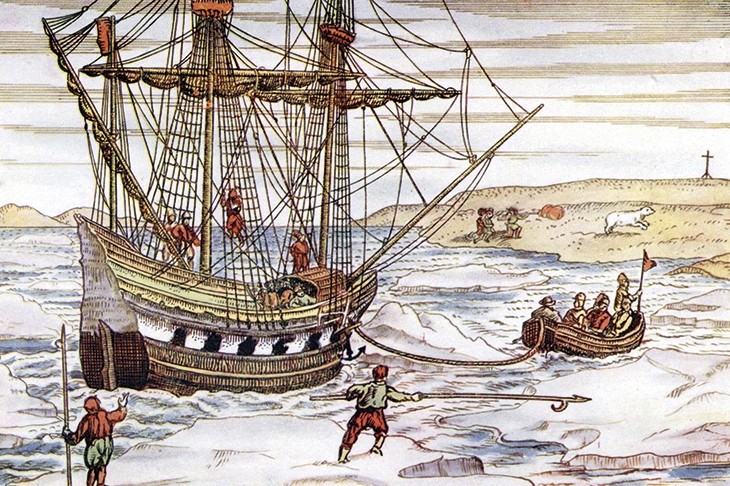Narratives of frozen beards in polar hinterlands never lose their appeal. Most of the good stories have been told, but in Icebound Andrea Pitzer fills a gap, at least for the popular reader in English, with the story of the 16th-century Dutch mariner William Barents. He sailed further north than any man before him and lives still, on the map, with an eponymous sea off the northern coasts of Norway and Russia.
In 1594, during the third decade of his country’s war with Spain, Barents voyaged to the unknown Nova Zembla (‘New Land’ in Dutch), planning to find a route to the fabled riches of Cathay. The notion of a navigable northern ocean had tantalized explorers since the Ancient Greeks, and geographers in Amsterdam thought the North Pole would be warm.
The Dutch Republic was just over a decade old when Barents set out, and certainly not the economic and naval powerhouse it would become. But, writes Pitzer, ‘with the flexibility, speed and economy of its shipbuilding ascendant, the new [country] found itself in the perfect position to stake a claim as a maritime empire’.
An American journalist whose previous books include One Long Night: A Global History of Concentration Camps, Pitzer is an able guide to Barents’s three Arctic voyages. On the first he piloted a three-masted vessel to 77° North, closer to the Pole than any European before him, and saw a bear that was white before the ice chased him home. On the second, in 1595, this time as coxswain and captain, not commander, seven men died, two in the jaws of a bear; then five were hanged for mutiny.
Who was Barents? Pitzer does not really know, and nor does anyone else. ‘He was likely in his forties when he left home,’ is characteristic of the speculative reportage in these pages, as is the information that he might have had a ‘nose like a chisel’, as the appendage appears in his most famous portrait: but that was painted three centuries after his death. He was certainly an accomplished navigator.
On the third voyage, in 1596, Barents discovered Spitsbergen. After a tantalizing glimpse of an open sea, the pincers of a floe trapped the ship and 17 men sat out temperatures in the minus 20s° F in the hastily constructed Het Behouden Huys, the Safe House. (I was once on Novaya Zemlya — as it is now called in Russian — and I wouldn’t fancy wintering in a small hut, eating roasted fox, the winds too strong for an outdoor bathroom.) The dark months unfurl in an agonizing quest for fresh food and firewood, and in a perpetual war against marauding bears. Scurvy afflicted everyone. Despite celebrating Twelfth Night with a special treat of one wheaten biscuit per man, they started dying off.
To break up the winter monotony, Pitzer works hard to establish context, whether of exploration in general or polar castaways in particular. Besides traveling in Barents’s footsteps, she has diligently mined the sources. Two men kept journals which have survived (though Barents did not), and Pitzer had them translated. They yield no glimpse of an inner life, however, and the reader will find none of the poetry of Frank Worsley in his unforgettable polar volume Shackleton’s Boat Journey, or of the determined pathos of Nansen’s account of his Arctic overwintering with the benighted Hjalmar Johansen.
***
Get a print and digital subscription to The Spectator.
Try a month free, then just $7.99 a month
***
When spring came they could not salvage the ship, so they set off for home in a herring boat and a rowboat. By this point, three quarters of the way through, the reader senses a dying fall. Then Barents does die. He did not exit pursued by a bear, either: he expired slowly of privation, his vision of a route to China still a dream. Pitzer embarks on a spirited exercise in his defense which takes many pages: why is Barents so famous when he achieved so little? I won’t spoil it, though there’s not a great deal to spoil, beyond the Farthest Norths and some mapping.
Pitzer’s prose is robust, clear and sometimes elegant. When the men shoot a swimming bear, ‘fat ran from the holes…blooming like oil in the water’. But occasionally the narrative takes a bathetic turn: ‘Meanwhile, the sea held dangers for everyone.’ A changing climate, of course, has created the open polar sea for which Barents risked everything.
Once the third voyage reached its conclusion, news spread throughout Europe from ‘the nested fist of Amsterdam harbor’. Three years later Shakespeare immortalized Barents in Twelfth Night when Fabian chides Sir Andrew Aguecheek: ‘You are now sailed into the north of my lady’s opinion, where you will hang like an icicle on a Dutchman’s beard.’
This article was originally published in The Spectator’s UK magazine. Subscribe to the US edition here.

























